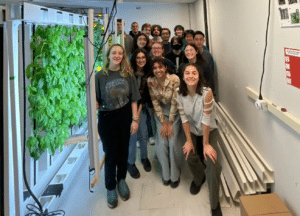Whether you keep a modest garden or manage a full greenhouse, pest control is probably one of your most time-consuming tasks. You can save time and keep your crops healthy by using a good IPM (integrated pest management) strategy. As part of an IPM strategy, you’ll want to use some cultural controls.
What is Cultural Pest Control?
“Cultural control” is a way of suppressing pests with the way you manage your production.
It’s about Interrupting an Insect’s Life Cycle
In a traditional agriculture system, common cultural controls would be tillage, strategic planting dates, or crop rotation- all practices that in some way interrupt an insect pest’s life cycle. A few of the old cultural controls can be rolled over to greenhouse production, of course, but a different setting requires that greenhouse producers rethink the way that they approach cultural controls.
Bright Agrotech has found several cultural control methods that fit our greenhouses and aquaponics setup.
Here are six cultural pest control methods to help you:
1) Keep your greenhouse clean to thwart pests
One method applicable to both traditional agriculture and greenhouse agriculture is sanitation. Plant debris and trash around your greenhouse provides shelter and often food for pests. You want your greenhouse to be as inhospitable to pests as possible. You know what that means… cleaning time.
Another sanitation technique that is frequently employed by greenhouses is the steaming of soil, crates, and pots before use. Steaming kills off many harmful bacteria and insect pests.
2) Controlling pests with plant-to-plant interactions (inter-cropping)
Inter-cropping (or companion planting) is another cultural control that is usually used because of the benefits from the plant-to-plant interaction, but it can also be utilized for pest control. The more plant species present, the higher the diversity.
When diversity goes up, several things happen. The first thing is that the pest no longer has a huge amount of its favorite food (or habitat) all in one place. Instead the “food plant” grows in patches. Some pests can’t travel very far and never make it out of their patch. This keeps the pest population from booming. Instead one large, widespread pest population, you have a few smaller – and less destructive/hopefully more manageable – populations.
3) Exclusion as a cultural pest deterrent
There are a lot of easy ways that you can implement exclusion, our third cultural control. Exclusion basically means keeping insects away. There are a lot of ways to do this mechanically, which is for another post, but there are also ways to do this culturally. One such way is crop spacing.
4) Excluding with crop spacing
Crop Spacing is important for one primary reason: plant bridges. Plant bridges are used by crawling pests (it doesn’t apply to flying pests) to travel from one plant to another. If you keep your plants from touching, you keep your pests from migrating. It is easier to squelch outbreaks that occur only on one plant than twenty.
[Dig a bit deeper: Learn proper plant spacing in aquaponics]
5) Excluding with trap crops
Trap Crops are plants that the pests prefer over your crops. Pests will be attracted to the trap crop, which then can (optional) be discarded along with all of its inmates. Check out this page to find some good trap crops for different pests.
6) Excluding with proper nutrient levels
Many grower’s don’t consider the importance of nutrient levels to pest control.
The primary nutrient you’ll want to be really careful about is nitrates, which impact the development and production rates of insects. (Especially aphids, which go bonkers if there is an abundance of nitrates.) Since nitrogen enters your system in the form of the protein from fish feed, your main tool for controlling nitrogen levels will be controlling your fish feed.







